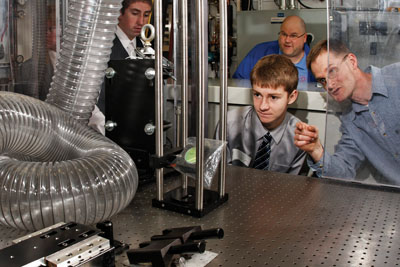Green Engineering Academy students visit Combustion Research Facility
As Kermit the Frog once lamented, it’s not easy being green. Students in the inaugural class of Livermore High School’s Green Engineering Academy are getting some help in living up to the connotations of that color — once synonymous with money, but now representing the environmental movement — through a partnership with Sandia. Last month, the Academy students and their teachers toured the Combustion Research Facility (CRF) and met the Sandia mentors who will guide their research.
“We are so lucky to have this great program right in our backyard with state-of-the-art technology so the students can see practical applications for the concepts they are learning in the classroom,” says Sue Johnston, an Academy teacher.

Through Lockheed Martin’s Gifts and Grants program, Sandia donated $10,000 to the Academy. Before he retired in December, Ray Ng organized the mentoring program that pairs 12 Sandians with the students and provides two math tutors and a presenter.
The 12 mentors are Ed Allen (8243-1), Larry Carrillo (8237), Lee Druxman (8231), David Franco (8112), Tricia Gharagozloo (8365), William Loo (8244), Jerry McNeish (8954), Mark Musculus (8362), Debbie Post (8248), Jack Skinner (8226), Elaine Yang (8226), and Derek Young (8229). Patty Hough (8954) and Jennifer Robles (8245) will provide math tutoring and Heather Jackson (8222) will give classroom presentations and hands-on lab demonstrations.
Obtaining matching grants
“This is really an incredible start to this program,” says Mike Waltz, another Academy teacher. “It’s really more than we had hoped for. The donation allows us to obtain all of the matching grant money available for this school year and the mentors give us a head start on meeting the mentor requirement next year.”
Lawrence Livermore National Laboratory, Schneider Electric, and Chevron Corp. have also provided financial support to the program.
The Green Engineering Academy is a “school within a school” focused on green technology and engineering. The California Partnership Academy (CPA) grant program provided an implementation grant of $29,000 last year and $42,000 in the current school year. The funding comes with the condition that the local school district match the full amount and that the program obtain matching funds from industry partners. In the 2011/12 school year, the grant increases to $72,000 and then to $81,000 in 2012/13, making industry partners even more crucial.
The LHS Academy launched this year with 35 sophomores, half of whom are at-risk, another requirement of the program. Each year, 30 new students will enter the Academy in their sophomore year. “We started with a bigger class this year because we expected some attrition,” says Johnston. “But everyone has stuck with the program and all the students are doing quite well.”
All classes have a science and engineering focus
The students take their core classes in science, English, social studies, and career technical education together with the same teachers from year to year. Those classes, even English and social studies, will have a science and engineering focus.
CPA requires that the students be matched with mentors in their junior year, usually from business partners. Waltz believes now that Sandia has stepped up with its support, other potential partners from the business community will come forward as well. “The first one is always the hardest and Ray really made this happen,” he says. “Now that the ball is rolling I think we’ll see a lot of momentum.”
Andy McIlroy (8350) welcomed the students to the CRF and explained some research areas. “Our work in the energy field spans a wide area and has a lot of impact,” he told the students. “The work that we do here in the CRF helped get you here today, quite literally.”
In small groups, the students rotated through the Hydrogen Combustion Lab, hosted by Victor Salazar (8362); Flame Diagnostics and Chemistry Lab, hosted by Nils Hansen and Scott Skeen (both 8353); Turbulent Combustion Lab, hosted by Isaac Ekoto and Adam
Ruggles (both 8367); Heavy Duty Diesel Lab, hosted by Mark Musculus; and the Alternative Fuels Engine Lab, hosted by Chuck Mueller (8362).
“The tour was pretty amazing,” LHS student Ben Davidson says. “It’s really interesting, all the cool stuff they do with alternative energy and hydrogen. I learned about the intricate ways that the researchers view what happens inside an internal combustion engine.”
Career familiarization
Waltz says that in addition to seeing interesting labs and equipment, the tour enabled the students to see what scientists really do day to day.
“I guess you’d call it career familiarization,” he says. “They hear about different jobs in science and engineering, but it’s much different to actually see where people work and the equipment they use. We also started building that relationship between the students and the mentors.”
The mentors will provide guidance and support to the students as they work on their projects for the Tri Valley Science and Engineering Fair in the spring. LHS student Emily Perry is considering a dance pad that generates electricity for her project. The idea, says Waltz, is to work up to the capstone research project that the students must complete in their senior year.
The 12 mentors from Sandia have 40 hours of paid time to spend with the Academy students. Elaine Yang says she volunteered to be a mentor because she sees it as a way to give back. “Mentors have made such a big difference in my life and career,” she explains. “That one-on-one interaction is really helpful.”